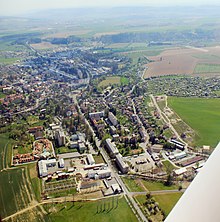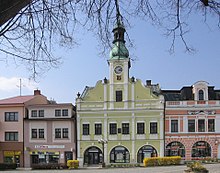Rychnov nad Kněžnou
| Rychnov nad Kněžnou | ||||
|---|---|---|---|---|
|
||||
| Basic data | ||||
| State : |
|
|||
| Region : | Královéhradecký kraj | |||
| District : | Rychnov nad Kněžnou | |||
| Area : | 3495 ha | |||
| Geographic location : | 50 ° 10 ' N , 16 ° 16' E | |||
| Height: | 320 m nm | |||
| Residents : | 10,998 (Jan 1, 2019) | |||
| Postal code : | 516 01 - 517 01 | |||
| structure | ||||
| Status: | city | |||
| Districts: | 8th | |||
| administration | ||||
| Mayor : | Jiří Rokl (as of 2007) | |||
| Address: | Svatohavelská 105 516 01 Rychnov nad Kněžnou |
|||
| Municipality number: | 576069 | |||
| Website : | www.rychnov-city.cz | |||
Rychnov nad Kněžnou ( German Reichenau an der Knieschna ) is a town in the Královéhradecký kraj in the Czech Republic . It is the seat of the Okres Rychnov nad Kněžnou of the same name and a member of the Euroregion Glacensis . The city is located about 30 kilometers east of Hradec Králové .
geography
Rychnov nad Kněžnou lies in the Eagle Mountains foothills on the Kněžná River . Neighboring towns are Skuhrov nad Bělou in the north, Liberk in the northeast, Rokytnice v Orlických horách in the east, Žamberk in the southeast, Vamberk and Doudleby in the south, Kostelec nad Orlicí and Častolovice in the southwest, Třebešov in the west and Solnice and Černíkovice in the northwest.
history
Reichenau was first mentioned in a document in 1258, when the royal chamberlain Hermann von Dürnholz ( Heřman z Drnholce ) was mentioned in a document of the later Bohemian king Přemysl Otakar II. , As "Hermanus de Richenawe". The guild of cloth makers is documented for the year 1378 . After Jan and Hynek von Reichenau fought on the side of the Taborites in the Hussite Wars , Emperor Sigismund viewed their possessions as a settled fiefdom and transferred the rule of Reichenau to his follower and Glatzer Provincial Governor Puta the Elder. J. von Častolowitz . After his death in 1434, the descendants of Jan von Reichenau, who died in 1433, succeeded in regaining ownership so that they retained the rule of Reichenau until 1497. As early as 1488, King Vladislav II confirmed the city's seal and coat of arms rights.
In 1497 Wilhelm II von Pernstein acquired the Reichenau rule, with whose heirs it remained until 1556. In that year it was acquired by the Glatzer pawnman Ernst von Bayern , from whom it passed to his nephew Albrecht von Bayern after his death in 1560 . In 1561 Emperor Ferdinand I made Reichenau a royal city . From 1577 to 1622 Reichenau belonged to the Trčka von Lípa and the Prague patrician family Betengel von Neuchâtel. Because of their participation in the Bohemian class uprising , Reichenau was confiscated and re-Catholicized by the emperor in 1622 and sold to the Libštejnský von Kolowrat in 1640 . From 1676 to 1690, Karl Libštejnský von Kolowrat built the baroque castle, in which a gallery with European paintings and family portraits and a library with a collection of manuscripts were set up. In 1714 the Piarists founded a grammar school with a college in Reichenau. From the first half of the 19th century, canvas and textile weaving were of economic importance.
Bohemian Brethren Union
From the second half of the 15th century, Reichenau developed into a center for the Bohemian Brothers . As one of their first followers, Johann d. J. von Reichenau (1447 – before 1478) known. In 1467 a synod of the Brethren was held in Lhotka near Reichenau, at which, among other things, it was decided to ordain its own priests . From 1592 to 1602 the then landlord Christoph Betengel von Neuchâtel built the late Gothic Trinity Church for the Brethren.
Jewish community
Even before 1567 there was a Jewish community in Reichenau . The Jewish cemetery , the oldest preserved tombs of which date from the end of the 17th century, has been documented since 1588. On the site of a synagogue that burned down in 1779 , a new one was built in 1782 and was used by the Jewish community until 1939. During the time of the occupation and after the Second World War during the rule of communism , it was used for other purposes. After the Velvet Revolution , it was renovated in the early 1990s and has served as a Jewish museum ever since.
Attractions
- Town hall on the old market square
- Rychnov nad Kněžnou Castle with a picture gallery
- The parish church of St. Gallus is the only surviving medieval building in Reichenau. It dates from the second half of the 13th century, was rebuilt in the late Gothic style in 1521 and changed to Baroque style in the 17th century.
- The late Gothic Trinity Church was built for the Brethren from 1592 to 1602 and was later rebuilt and given a baroque facade.
- Synagogue from 1781/82 with a Jewish museum
- Jewish cemetery from 1588
Twin cities
Districts
The town of Rychnov nad Knežnou includes the villages of Dlouhá Ves ( Langendorf ), Habrová ( municipal beeches ), Jámy ( pits ), Lipovka ( Lindenhof ), Litohrady ( Lüttenburg ), Lokot ( Neulakot ), Panská Habrová ( Herrenbuchen ) and Roveň ( Rowen ) .
Personalities
- Josef Karl Homma (1891–1966), author of historical writings and director of the Burgenland State Archives
- Remigius Machura (* 1960), Czech shot putter
- Stanislav Novák (1890–1945), violinist
- Franz Martin Pelzel (1734–1801), Bohemian historian, Slavist and author
- Josef Bernhard Pelzel Edler von Pelzeln (1745–1804), secretary, civil servant and ecpanditor, brother of Franz Martin Pelzel
- Rudolf Rokl (1941–1997), jazz musician
- Ludwig Spiegel (1864–1926), German-Bohemian lawyer
- Karel Poláček (1892–1945), Czech writer and journalist
- Miloš Řezník (* 1970), Czech historian
The Slovak opera singer Helena Bartošová-Schützová (1905–1981) died in Reichenau an der Knieschna .
literature
- Joachim Bahlcke , Winfried Eberhard, Miloslav Polívka (eds.): Handbook of historical places . Volume: Bohemia and Moravia (= Kröner's pocket edition . Volume 329). Kröner, Stuttgart 1998, ISBN 3-520-32901-8 , p. 513 f.
Web links
Individual evidence
- ↑ Český statistický úřad - The population of the Czech municipalities as of January 1, 2019 (PDF; 7.4 MiB)
- ↑ Ondřej Felcman: "Český koutek" v Kladském Hrabství - Yeho české Koreny a následné vztahy k českému sousedství. In: Český koutek v Kladsku , Kladský sborník , Supplementum. Univerzita Hradec Králové, Hradec Králové 2008, ISBN 978-80-903509-8-4 , pp. 23–34, here p. 28, note 12.





